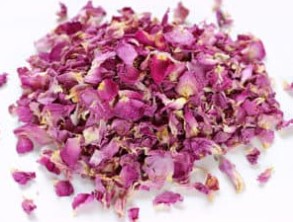Product Description
Rosa damascena is a 2-3 m high tortoise of the Rosaceae family. The root system is highly developed, consisting of adventitious roots. The skeletal roots are brown, with a rope-like shape, reaching up to 4 meters deep, with a large number of branches and a high suction power.
The young shoots are grassy-green, covered with straight or slightly curved down red brown spines, of different size and color. Stems and young Lexicus have a thick core. In their aging, their joints and spikes lose their green-green color and gradually become brown, and the spikes are gray. Rats without spikes are rare.
The leaves of Rosa damascena are consecutive, with foliage, leucoptera, olives or reed, and the flower stems are revealed from the buds on the tops of the one-year branches.
The flowers of rosa Damascena are red or pink, large, located several on the tops of their stems and branches, in crooked inflorescences. Chapels are 5, they do not. The crown is composed of 20-30 normal and more and 5-10 deformed petals with a strong pleasant aroma.
Blooms in May-June. It is propagated by dividing old pink bushes, by grafting, rooting cuttings, etc. In autumn, the rose shrubs are fastened with finger to prevent dropping.
It is believed that the Kazanluk rose is a hybrid between Rosa Gallica L. and Rosa Canina L. In Bulgaria, the Kazanluk rose begins in March at an average daily temperature of 8 degrees and ends its reproductive stage in June.
The most favorable climatic conditions for synthesizing a larger quantity of essential oil are the moderate temperatures and high atmospheric humidity. As well as the conditions of our sub-Balkan valley, known all over the world as the Rose Valley.
The Rosa Damascena was brought to Bulgaria at the end of the 17th and the beginning of the 18th century. It was first grown only around Kazanlak and the nearby villages where the colors produced only rose water to satisfy the Turkish Empire. By the middle of the 19th century it was already spread from Kazanlak east to Sliven and west to Klissura.
Use fresh rose flowers (Flores Rosae) and rose essential oil (Oleum Rosae). Picking May – June. The pink color is done manually, producing colorful flowers and only in the morning in sunny and warm weather from 5 to 7 hours and in cold and cloudy from 7 to 9 hours. The selected rose flowers outside of these hours is poor on pink oil, and the flower picked up is given up to 10 o’clock. The average yield or decare of pink flower is 150-250 kg.
The Bulgarian rose oil has a clear color with a greenish hue. Consistency resembles almond oil. It has a strong aroma and an acute balsamic taste.
The use of rose oil and rose water in ancient times not only in cosmetics. Also for medicinal purposes for scalds, eye diseases, tuberculosis, embalming and mummification of carcasses, etc. Compared to other rose oils, Bulgarian rose oil has the finest and lasting aroma. It is very used in the production of almost all first-class perfumery products.
The main raw material is also for a number of medicines. Rose water (only that obtained from the distillation of rose oil) has an antiseptic effect on eye inflammation in catarrhal and hypertrophic gingivitis. The fresh rose flower has good adstrung and clamping action for stomach upsets, diarrhea, etc.
Rose essential oil has anti-inflammatory and anti-inflammatory action in pulmonary abscesses and gangrene.
The rose concrete has been used in surgical practice to treat severe inflammatory wounds, radio-anesthesia. For postoperative injuries, burns, inflamed wounds, varicose ulcers. Bulgarian rose oil has an anti-inflammatory and bactericidal action. Kazanlak Rose is used in the food industry as a raw material for various types of jams and jellies.
Rose petals powder (Rosa Damascena flower powder) is created from the finest 100% natural dry rose petals. It has a sweet flowery fragrance end high in vitamin C. Rose petals powder (Rosa Damascena flower powder) It has anti-inflammatory, antibacterial and antioxidant effects and is therefore widely used in cosmetics. It is natural, cruelty free, vegan and free from chemical additives. Rose petals powder (Rosa Damascena flower powder) also used in cooking. Most commonly used in Middle Eastern, North African and European cuisines lending their incomparable aroma and light, tart-sweet flavor to syrups, oils, sauces.

